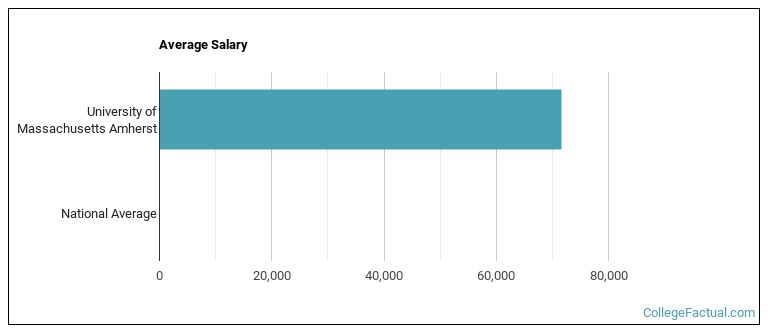 by our College Data Analytics Team
by our College Data Analytics Team
College Factual recognizes the best colleges and universities in its annual rankings. These rankings include categories for best overall colleges, best colleges for each major, best value schools, and much more.
University of Massachusetts Amherst was awarded 139 badges in the 2025 rankings. The highest ranked major at the school is general psychology.
Explore the best ranked schools for the programs you are most interested in.
According to College Factual's 2025 analysis, UMass Amherst is ranked #60 out of 2,152 schools in the nation that were analyzed for overall quality. This lands it a coveted spot in the top 5% of all colleges and universities in the country. This is an improvement over the previous year, when UMass Amherst held the #81 spot on the Best Overall Colleges list.
UMass Amherst also holds the #10 spot on the Best Colleges in Massachusetts ranking.
See all of the rankings for University of Massachusetts Amherst.
The acceptance rate at University of Massachusetts Amherst is a competitive 64%, so make sure you take your application seriously when putting it together. Even leaving out a minor detail could be a reason to move you to the rejection pile.
About 30% of students accepted to UMass Amherst submitted their SAT scores. When looking at the 25th through the 75th percentile, SAT Evidence-Based Reading and Writing scores ranged between 630 and 720. Math scores were between 630 and 760.
Learn more about University of Massachusetts Amherst admissions.
The student to faculty ratio is often used to estimate how much interaction there is between professors and their students at a college or university. At University of Massachusetts Amherst, this ratio is 18 to 1, which is on par with the national average of 15 to 1. That's not bad at all.
In addition to the student to faculty ratio, some people look at what percentage of faculty members are full-time as a sign of how much time professors will be able to spend with their students. This is because part-time teachers may not be be on campus as much as their full-time counterparts.
The full-time faculty percentage at University of Massachusetts Amherst is 79%. This is higher than the national average of 47%.
University of Massachusetts Amherst has a freshmen retention rate of 90%. That's a good sign that full-time students like the school and their professors enough to want to stick around for another year. It's also a sign that the admissions team did a good job in choosing applicants who were a good fit for the school.
Students are considered to have graduated on time if they finish their studies within four years. At UMass Amherst the on-time graduation rate of first-time, full-time students is 76%. That is great when compared to the national average of 33.3%
Find out more about the retention and graduation rates at University of Massachusetts Amherst.
During the 2017-2018 academic year, there were 24,233 undergraduates at UMass Amherst with 22,212 being full-time and 2,021 being part-time.
| $0-30 K | $30K-48K | $48-75 | $75-110K | $110K + |
|---|---|---|---|---|
| $10,858 | $11,824 | $15,768 | $22,651 | $29,809 |
The net price is calculated by adding tuition, room, board and other costs and subtracting financial aid.Note that the net price is typically less than the published for a school. For more information on the sticker price of UMass Amherst, see our tuition and fees and room and board pages.
Almost 66% of college students who graduated with the class of 2018 took out student loans, but that percentage varies from school to school. At UMass Amherst, approximately 51% of students took out student loans averaging $8,481 a year. That adds up to $33,924 over four years for those students.
The student loan default rate at UMass Amherst is 1.0%. This is significantly lower than the national default rate of 10.1%, which is a good sign that you'll be able to pay back your student loans.
Get more details about paying for University of Massachusetts Amherst.

See which majors at University of Massachusetts Amherst make the most money.
Get more details about the location of University of Massachusetts Amherst.

Contact details for UMass Amherst are given below.
| Contact Details | |
|---|---|
| Address: | 374 Whitmore Building 181 Presidents Drive, Amherst, MA 01003 |
| Phone: | 413-545-0111 |
| Website: | www.umass.edu/ |
| Most Popular Majors | Bachelor’s Degrees | Average Salary of Graduates |
|---|---|---|
| Business Administration & Management | 749 | $64,138 |
| Computer Science | 577 | $88,554 |
| General Psychology | 567 | $32,223 |
| Public Health | 402 | $37,364 |
| Economics | 384 | $52,309 |
| Communication & Media Studies | 321 | $36,380 |
| General Biology | 317 | $40,427 |
| Other Multi/Interdisciplinary Studies | 316 | $47,762 |
| Accounting | 305 | $67,574 |
| Finance & Financial Management | 289 | $68,920 |
Online learning options are becoming more and more popular at American colleges and universities. Online classes are great for students who have busy schedules or for those who just want to study on their own time.
In 2022-2023, 6,916 students took at least one online class at University of Massachusetts Amherst. This is an increase from the 6,454 students who took online classes the previous year.
| Year | Took at Least One Online Class | Took All Classes Online |
|---|---|---|
| 2022-2023 | 6,916 | 3,853 |
| 2021-2022 | 6,454 | 4,105 |
| 2020-2021 | 30,293 | 26,059 |
| 2018-2019 | 6,503 | 3,607 |
Learn more about online learning at University of Massachusetts Amherst.
If you’re considering University of Massachusetts Amherst, here are some more schools you may be interested in knowing more about.
Curious on how these schools stack up against UMass Amherst? Pit them head to head with College Combat, our free interactive tool that lets you compare college on the features that matter most to you!
Footnotes
*The racial-ethnic minorities count is calculated by taking the total number of students and subtracting white students, international students, and students whose race/ethnicity was unknown. This number is then divided by the total number of students at the school to obtain the racial-ethnic minorities percentage.
References
More about our data sources and methodologies.